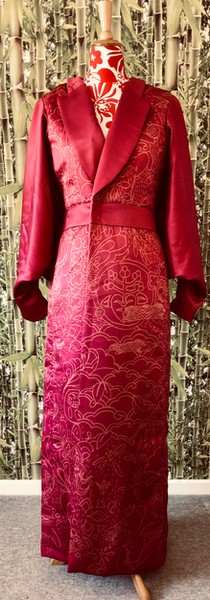
Projects
Personal projects for competitions and
education
Hand and Lock 2024
Kyoto night scape inspired embroided jacket with draped back.
Tailoring
Hand and Lock 2022
 |  |  |  |
|---|---|---|---|
 |  |
The Hand and Lock Prize for Embroidery 2022 - fashion category
Harness with 3D printed embellishments on top of sashiko embroidery - inspired by tree bark
Final Major Project - University

Rationale
Final Major Project - Concept Development
The concept I am proposing is based around Japan and its culture - both historical and modern. I will be considering the relationship between craft and technology, contextualising it with native Japanese influences, from historical cultural ideas, such as Shinto, a belief in the sacred power of nature.
My Garments being inspired with the concept of repairing damage with embroidery, inspired by the way the Hibia trees adapts to damage, making both look unique, a sacred tree in Japan. Stitching with gold and copper threads to show the imperfections and to document the story of the garment.
I will be looking to the modern sense of design, from integrated technology such as animatronics to sustainable craft ideals to influence the concept. The kimono, a staple item in the Japanese wardrobe, has been a key influence in the development of the garments and textiles; Itchiku Kubota, a textiles artist from Japan, inspired the embroidery and fabric manipulation development of my own work.
Sashiko, an art of embroidery has also informed the development, with this being integrated with the fabric manipulations inspired by Itchiku Kubota to create a depth and texture reminiscent of the Japanese textile art of Tsujigahana- a variant of the technique shibori.
The Cut of the garments will be a cross of European tailoring and Japanese kimono. The silhouette being more European but the textiles and collar, reflecting the kimono, the collar being rolled back to reveal the neck and the vibrancy of the lining, of which would be a stark contrast to the exterior.
The details of each piece need to be subtle at a distance and impactful close, to be noticed by only the ones who would pay attention. This an idea of the versatile effect the garments will have, adding to the ecological aspect for the less need for multiple outfits.

Sashiko Project


Rationale
Industry Project
In combination, Scabal and Generation Z, form the basis of this brief. When researching Scabal, key ideas and the company’s ethos become clear – craftsmanship and heritage are explicit throughout their history, with an openness to new creative concepts to satisfy their clientele’s discerning eye. This became apparent when looking at their swatches embellished with gold, platinum and diamonds, as well as fully appreciating their inherent ethical and sustainable practices when developing exquisite fabric. Scabal’s philosophy, together with aspects of bespoke tailoring, resonate with Generation Z. The client, as I envisage, is someone who would choose a handmade ceramic travel mug because of craftsmanship, beauty and sustainability over a purely utilitarian alternative. The client within Generation Z is one that dresses for elegant comfort within sustainability. A garment for most circumstances – quality over quantity. As a prediction, Generation Z will become more ecologically and ethically accepting and start to move away from high street fashion; prizing craftsmanship and narrative over mass production. As reported by WGSN, 67% of Generation Z look for a narrative when purchasing, correlating with my prediction. With this in mind, an idea of personal individuality becomes even more important. Using this along with three Japanese aesthetic concepts: Kintsugi – the art of repairing ceramics with gold, creating an understanding that the piece is more beautiful for having been broken, and a concept that could resonate with Generation Z; Wabi-Sabi – the art of imperfect beauty and Sashiko – the art of decorative reinforcement stitching, forms the basis of inspiration for my project. Using the Japanese ideals bring the idea of luxury repair, embellishing faults with gold or in the case of my collection, copper thread. The idea of the more a garment is worn and aged, the more personal it becomes, lovingly documenting a historical journey through repair. A personal commentary can be represented through repair, such as discreet messages within embroidery. I chose to use this by including my grandmother’s astrology sign who had died shortly before the project began. My final garment has been developed from the notion of timeless elegant that is comfortable and eye-catching. Within Generation Z and the idea of the 8 second appeal – where if the viewer does not engage within this time, the opportunity is lost – therefore, eye-catching is an essential element of this garment. I have chosen to use a flair instead of a vent to give not only a subtle contemporary look but more freedom and therefore comfort. I echoed this comfort in my choice of sleeve ribbing instead of vents and inserted gusset, in the under arm, for additional freedom of movement. To continue the contemporary look, the shoulders have been removed to give a more feminine and elegant appeal. I created a single lapel to add a minimalistic elegance and used copper thread for embroidery. Ethical sustainability will become the forefront of Generation Z’s purchasing behaviour. A change in mentality with ethical and aesthetic focus combining and dictating their future buying habits; something that resonates with Scabal philosophy today.










































































